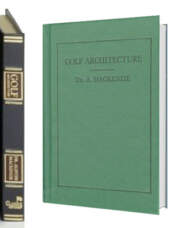$75.00Add to cart
By Dr. Alister MacKenzie Dr. MacKenzie’s Golf Architecture was a monumental book for its time, a timeless book on golf architecture and a must for any student of the field or serious player. MacKenzie was an outdoorsman, a military man, and a doctor of medicine, whose hobby of golf architecture got the best of him. He ultimately abandoned his medical career to pursue golf course architecture and we must be thankful for that. He fully understood the nuances of the game but his genius was borne from his astute analysis of the nature of the course, its purpose and place in golf. One of the elemental distinctions he made was between strategic hazards (primarily sand bunkers, as he abhorred water as a penalty) and random hazards, as were commonly found on Scottish links—most notably at his beloved St. Andrews. The penal school of architecture was in vogue during much of MacKenzie’s life but he would have none of it. His conception of a perfect course had to do with surrounding the player, frequently challenging him, but ultimately enabling him the freedom to play, to enjoy his day at golf. MacKenzie felt too many golfers looked on hazards “as a means of punishing a bad shot, when their real object is to make the game interesting.” When his masterpiece, Augusta National Golf Club opened there were only 23 bunkers, barely more than one per hole. “Hazards should be placed with an object, and none should be made which has not some influence on the line of play...” While he is in complete agreement with John L. Low’s 1903 comment in Concerning Golf that no hazard is unfair wherever it is placed, MacKenzie avows “a hazard placed in the exact position where a player would naturally go is frequently the most interesting situation, as then a special effort is needed to get over or avoid it.” In one of the lectures that constitute this volume, MacKenzie identifies thirteen quintessential traits of the best golf architecture—the thirteen commandments for the zealous. Some are elementary: the next tee should be nearby the last green and in a direction away from following players; every hole should be of a different character and every course should have four par-threes, a couple of drive-and-pitch holes, but mostly substantial par-fours. Many qualities are more complicated: “The course should be so arranged so that the long handicap player, or even the absolute beginner, should be able to enjoy his round in spite of the fact that he is piling up a big score.” Besides ranking as one of the finest volumes on golf architecture, this book is valuable for the good course management it teaches, especially to those neophytes. Golfers must use their minds and act with authority; after all, this is war. MacKenzie was a military specialist in camouflaging earthworks; it was that peculiar skill that shaped his concepts for strategic bunkering. MacKenzie’s simple formula for a good golf course is twofold: it must never become monotonous; and the best course construction is “almost entirely due to utilization of natural features to the fullest extent and to the construction of artificial ones indistinguishable from nature.” He was also one of the earliest proponents of hazards to putting, designing unique greens such as the seventeenth at Augusta where the vertical halves slope in opposite directions, or the fifth with its backward tiering. He wanted the route to the green to be generous, never lined with ball-gobbling rough or ponds, but he could also be audacious when given property with substantially different terrain, as on the Monterey Peninsula for Cypress Point. Wisely there, the green movement is more tempered due to the high risk factor of many other shots, and perhaps the distracting drama of the surrounds. Admirers of the art of Mackenzie in the U. S. should also view Ohio State University GC, the University of Michigan GC and Crystal Downs CC, Green Hills CC (CA ), Pasatiempo GC, Northwood GC and Stockton G & CC. While totally serious and eminently important, this book is far from a chore to read. Although a stern, physically imposing Scot, MacKenzie liked a joke, even if at possibly his own expense. One of two rival green shapers admitted he could never quite achieve the subtle contours of the other, and asked his secret. “The other replied that it was perfectly easy; he simply employed the biggest fool in the village and told him to make them flat.” Foreword by Herbert Warren Wind, Afterword by Lewis A Lapham.-

$65.00Add to cart
By Charles B. Macdonald One of the masterpieces of golf literature by America's first official golf champion and one of its foremost golf architects. Afterword by Alister Cooke. -

$50.00Add to cart
By H.N. Wethered and T. Simpson The Architectural Side of Golf, written at the close of the golden era of golf architecture, is the discipline’s grandest literary gem. It is the last and most lavish of the several books on design published during the 1920s, with 44 plates drawn by Simpson and 26 etchings by Wethered. The authors reaped the benefit of seeing prior publications and crafted this to be as little like a textbook as possible, while exploring a wide variety of subjects directly and indirectly related to architecture. Excepting Sutton’s 1933Golf Courses: Design, Construction and Upkeep, this would be the last book published on golf course architecture for decades. Familiar to designers, The Architectural Side of Golf should also be in the hands of amateurs and committee persons who tinker with re-design or contemplate alteration of their home courses. The authors surmise the golf course is at a crossroads. In the 1920s, they say, gone are the carefree days of yore when the players were “a mere handful of local enthusiasts who did not, perhaps, take the game in quite as serious a spirit as is the present custom.” The modern ball and clubs produce better, longer shots of controlled shapes in the hands of the pros. Match play has given way to stroke play and thus increased attention to every strike. This is modern golf, attacking all the time, shooting for the pin. The best players now practice regularly—even putting—and thereby invent all manners of shots to escape trouble. The authors ponder how an architect can defend the onslaught against par. In the beginning of the 21st century, we frequently hear critics argue, “today’s golf ball goes too far.” Distance was as hot a topic in the Roaring Twenties as it is now. How accurate Simpson and Wethered were in their prediction about balls: “In all probability there is still room for an additional length quite sufficient to upset present calculations.” Another concern for architects of that era—and this—is the degree to which wedge play had been perfected. The design solutions for today are as then. In the search to frustrate the constantly dropping scores, success is not to be found in lengthening the holes—the ball will keep going further. Rather, allow semi-rough come into play more, make primary rough penal; reduce the size of the greens and remove backdrops that provide clues to distance; let every bunker and hazard be strategic. Finally, keep everything in proportion caution the authors. Remember that only one percent of golfers are “cracks” and the average guys are the ones who really keep the club afloat. Wethered and Simpson challenge all designers not to fail in any of the obvious points for building courses: every hole should be interesting; the maximum variety of holes allowed by the site should be provided; the natural beauty of the country should be impaired as little as possible; a premium should be put on good golf; and the course should be equally interesting and amusing to the first-rate and the second-rate golfer. The discipline needed to abide by these hard and fast rules is more than many architects have been able to muster. One of the outstanding features of this book is the use of hole and feature drawings to illustrate the text, many from courses unvisited by even the most ardent seekers, like Chantilly, Liphook, Waddesdon, Chiberta-Biarritz, and Morfontaine. The effect of this feature is most evident in the authors’ interesting discussion about the ideal golf course. Before presenting their favorite 18, and they are all winners, Wethered and Simpson firmly denounce any attempt to actually build such a composition course. Suppose, they say, every hole was of a strength and character of the 17th at St. Andrews Old: “The strain of it all!…It would certainly break our hearts and leave us nervous wrecks or golf lunatics in real earnest.” We can all join in this pleasant theoretical exercise. This is an especially nice book if you like St. Andrews. Different chapters cover the South of England, Northern Scotland, and East Lothian, but the authors clearly are enamored with the Old Course. Many of the references throughout the text relate to the venerable links, especially so in the unique section entitled The Reversible Golf Course. There is camaraderie amid history and philosophy, notably in the chapterCaddies We have Met. One particular caddie had “the appearance of a bird of prey, with hooked nose and fierce bright eyes glimmering at one, and a look that was commanding yet inscrutable…carried the clubs under his arm in the old manner, as if prepared to charge the enemy with the bayonet at the least provocation.” Having been treated with diplomatic firmness throughout the round, the author felt it “expedient to dribble a small stream of silver into his palm until there were signs of a sufficiency to appease his humour.” Equally imaginative—and surprisingly prescient on the topic of architecture—is a chapter on home golf,In an English Garden. The often subtle but pervasive philosophy in The Architectural Side of Golf is as important and sound as the technical advice. The new culture of golf began in a whirl when vastly more people began to play, equipment improved dramatically and courses were routinely constructed inland. Whatever it was before, golf became a blend, an amalgamation of art and science. More than anything, it became paramount that the architect be alert to their proper balance. Science can overpower the artistry of man imitating nature, just as seeking perfection in artistry can confound science. Given the fluid nature of golf and its components, it is a testimony to the value of this work that its subjects remain germane in any given greens committee meeting today. Foreword by Herbert Warren Wind.

